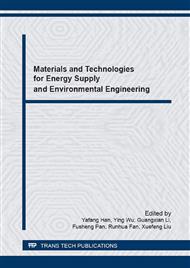[1]
R.S. Selinsky, Q. Ding, M.S. Faber, J.C. Wright, S. Jin, Quantum dot nanoscale heterostructures for solar energy conversion, Chem. Soc. Rev. 42 (2013) 2963-2985.
DOI: 10.1039/c2cs35374a
Google Scholar
[2]
D. Rickard, J.W. Morse, Acid volatile sulfide (AVS), Mar. Chem. 97 (2005) 141–197.
DOI: 10.1016/j.marchem.2005.08.004
Google Scholar
[3]
M. Wang, C. Xing, K. Cao, L. Zhang, J. Liu, L. Meng, Template-directed synthesis of pyrite (FeS2) nanorod arrays with an enhanced photoresponse, J. Mater. Chem. A 2 (2014) 9496–9505.
DOI: 10.1039/c4ta00759j
Google Scholar
[4]
A. Kirkeminde, R. Scott, S. Ren, All inorganic iron pyrite nano-heterojunction solar cells, Nanoscale 4 (2012) 7649-7654.
DOI: 10.1039/c2nr32097e
Google Scholar
[5]
H.A. Macpherson and C.R. Stoldt, Iron pyrite nanocubes: size and shape considerations for photovoltaic application, Acs Nano 6 (2012) 8940-8949.
DOI: 10.1021/nn3029502
Google Scholar
[6]
S.C. Hsiao, C.M. Hsu, S.Y. Chen, Y.H. Perng, Y.L. Chueh, L.J. Chen, Facile synthesis and characterization of high temperature phase FeS2 pyrite nanocrystals, Mater. Lett. 75 (2012) 152-154.
DOI: 10.1016/j.matlet.2012.02.033
Google Scholar
[7]
D.R. Cummins, H.B. Russell, J.B. Jasinski, M. Menon, M.K. Sunkara, Iron Sulfide (FeS) nanotubes using sulfurization of hematite nanowires, Nano letters 13 (2013) 2423-2430.
DOI: 10.1021/nl400325s
Google Scholar
[8]
A.M. Golsheikh, N.M. Huang, H.N. Lim, C.H. Chia, I. Harrison, M.R. Muhamad, One-pot hydrothermal synthesis and characterization of FeS2 (pyrite)/graphene nanocomposite, Chem. Eng. J. 218 (2013) 276-284.
DOI: 10.1016/j.cej.2012.09.082
Google Scholar
[9]
R. Wu, Y.F. Zheng, X.G. Zhang, Y.F. Sun, J.B. Xu, J.K. Jian, Hydrothermal synthesis and crystal structure of pyrite, J. Cry. Grow. 266 (2004) 523–527.
DOI: 10.1016/j.jcrysgro.2004.02.020
Google Scholar
[10]
D.W. Wang, Q.H. Wang, T.M. Wang, Controlled growth of pyrite FeS2 crystallites by a facile surfactant-assisted solvothermal method, Cryst. Eng. Comm. 12 (2010) 755–761.
DOI: 10.1039/b917941k
Google Scholar
[11]
J. Xu, H. Xue, X. Yang, H. Wei, W. Li, Z. Li, W. Zhang, C. Lee, Synthesis of Honeycomb-like Mesoporous Pyrite FeS2 Microspheres as Efficient Counter Electrode in Quantum Dots Sensitized Solar Cells , Small 10(2014).
DOI: 10.1002/smll.201401102
Google Scholar
[12]
M. AlamKhan, M.O. Manasreh, Y. Kang, Characterization and optoelectronic properties of iron pyrite nanohusks, Mater. Lett. 126 (2014)181–184.
DOI: 10.1016/j.matlet.2014.04.060
Google Scholar
[13]
L. Zhu, B.J. Richardson, Q. Yu, Controlled colloidal synthesis of iron pyrite FeS2 nanorods and quasi-cubic nanocrystal agglomerates, Nanoscale 6 (2014) 1029–1037.
DOI: 10.1039/c3nr04979e
Google Scholar
[14]
D.W. Wang, Q.H. Wang, T.M. Wang, Shape controlled growth of pyrite FeS2 crystallites via a polymer-assisted hydrothermal route, Cryst. Eng. Comm. 12 (2010) 3797-3805.
DOI: 10.1039/c004266h
Google Scholar
[15]
R.A. Berner, The synthesis of framboidal pyrite, Econ. Geol. 64 (1969) 383-384.
Google Scholar
[16]
B. Kříbek, The origin of framboidal pyrite as a surface effect of sulphur grains, Mineralium Deposita 10 (1975) 389-396.
DOI: 10.1007/bf00207896
Google Scholar
[17]
C. Wadia, Y. Wu, S. Gul, S.K. Volkman, J.H. Guo, A.P. Alivisatos, Surfactant-assisted hydrothermal synthesis of single phase pyrite FeS2 nanocrystals, Chem. Mat. 21 (2009) 2568-2570.
DOI: 10.1021/cm901273v
Google Scholar
[18]
A. Kirkeminde, P. Gingrich, M.G. Gong, H.Z. Cui, S.Q. Ren, Iron sulfide ink for the growth of pyrite crystals, Nanotechnology 25 (2014) 205603.
DOI: 10.1088/0957-4484/25/20/205603
Google Scholar
[19]
G.W. Luther, Pyrite synthesis via polysulfide compounds, Geochim. Cosmochim. Ac. 55 (1991) 2839-2849.
DOI: 10.1016/0016-7037(91)90449-f
Google Scholar
[20]
E.J. Kim and B. Batchelor, Synthesis and characterization of pyrite (FeS2) using microwave irradiation, Mater. Res. Bull. 44 (2009) 1553-1558.
DOI: 10.1016/j.materresbull.2009.02.006
Google Scholar


